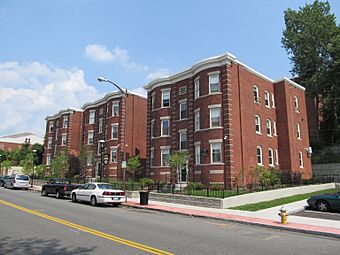Upper Worthington Historic District facts for kids
Quick facts for kids |
|
|
Upper Worthington Historic District
|
|

City View Commons
|
|
| Location | Springfield, Massachusetts |
|---|---|
| Area | 9 acres (3.6 ha) |
| Built | 1908 |
| Architect | Gagnier & Angers et al. |
| Architectural style | Colonial Revival, Moderne, Tudor Revival |
| NRHP reference No. | 83000773 |
| Added to NRHP | March 31, 1983 |
The Upper Worthington Historic District is a special area in Springfield, Massachusetts. It has many apartment buildings that look alike. These buildings show one of the biggest housing projects in the city from the early 1900s.
The district is mainly on Worthington Street, a major road. It stretches between Armory Street and Summit Street. It also includes buildings on Federal and Taylor Streets. Most of the buildings are four stories tall and made of brick. They have a classic style with stone details. This area was first listed on the National Register of Historic Places in 1983. It was made larger in 1992 to include more buildings.
Where is the Upper Worthington Historic District?
The district is located on the northern side of a flat area. This area also holds the famous Springfield Armory. In the mid-1800s, this land had large summer homes. But as the city grew, people wanted more housing. So, these estates were eventually used for new buildings.
How the District Was Built
The Upper Worthington area was once the estate of Horace Kibbe. In 1908, a company called Gagnier & Angers wanted to buy it. This company was run by two French Canadian immigrants. They were important builders and real estate developers in Springfield.
In 1912, they bought the largest part of the estate. Over the next twenty years, they built many homes there. Most of the apartment buildings in the district were built by them. Some were also built by a company started by their sons. This project was the biggest of its kind in Springfield at the time. It still shows what the streets looked like back then.



